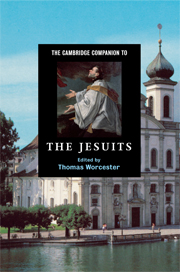Book contents
- Frontmatter
- Introduction
- Part I Ignatius of Loyola
- Part II European Foundations of the Jesuits
- Part III Geographic and Ethnic Frontiers
- Part IV Arts and Sciences
- 13 Jesuit architecture in colonial Latin America
- 14 The Jesuits and the quiet side of the scientific revolution
- Part V Jesuits in the Modern World
- Select bibliography
- Index
13 - Jesuit architecture in colonial Latin America
from Part IV - Arts and Sciences
Published online by Cambridge University Press: 28 September 2008
- Frontmatter
- Introduction
- Part I Ignatius of Loyola
- Part II European Foundations of the Jesuits
- Part III Geographic and Ethnic Frontiers
- Part IV Arts and Sciences
- 13 Jesuit architecture in colonial Latin America
- 14 The Jesuits and the quiet side of the scientific revolution
- Part V Jesuits in the Modern World
- Select bibliography
- Index
Summary
Few architectural traditions were as deeply affected by the Society of Jesus as those of colonial Latin America, particularly South America between the late sixteenth and late eighteenth centuries. Whereas the Jesuits made a profound impact on the architecture of other parts of the world - notably Baroque Italy, central Europe, and Flanders - Jesuit monuments played a paradigmatic role in certain regions of Latin America, frequently inspiring trends that would prevail for decades thanks to structural, stylistic, and decorative innovations. Such were the cuzqueño Baroque, a bold and unique variant of Baroque architecture that arose phoenix-like from the rubble of the 1650 Cuzco earthquake, and the so-called “Mestizo Style,” an extraordinarily creative movement in architectural sculpture that spread rapidly through the southern Andes between the 1660s and the 1820s. In other regions, such as modern-day Paraguay, parts of Argentina, and lowland Bolivia, the Jesuits so dominated the built environment that Jesuit architecture and regional architecture were one and the same. Despite this profound architectural legacy in colonial Latin America, the Jesuits did not promote any single style. In fact, the buildings they constructed from Baja California to Chilean Patagonia were noteworthy for their lack of stylistic unity, the result both of their policy of adaptation to regional and indigenous forms and the unusually international background of Jesuit architects and designers.
- Type
- Chapter
- Information
- The Cambridge Companion to the Jesuits , pp. 217 - 242Publisher: Cambridge University PressPrint publication year: 2008



